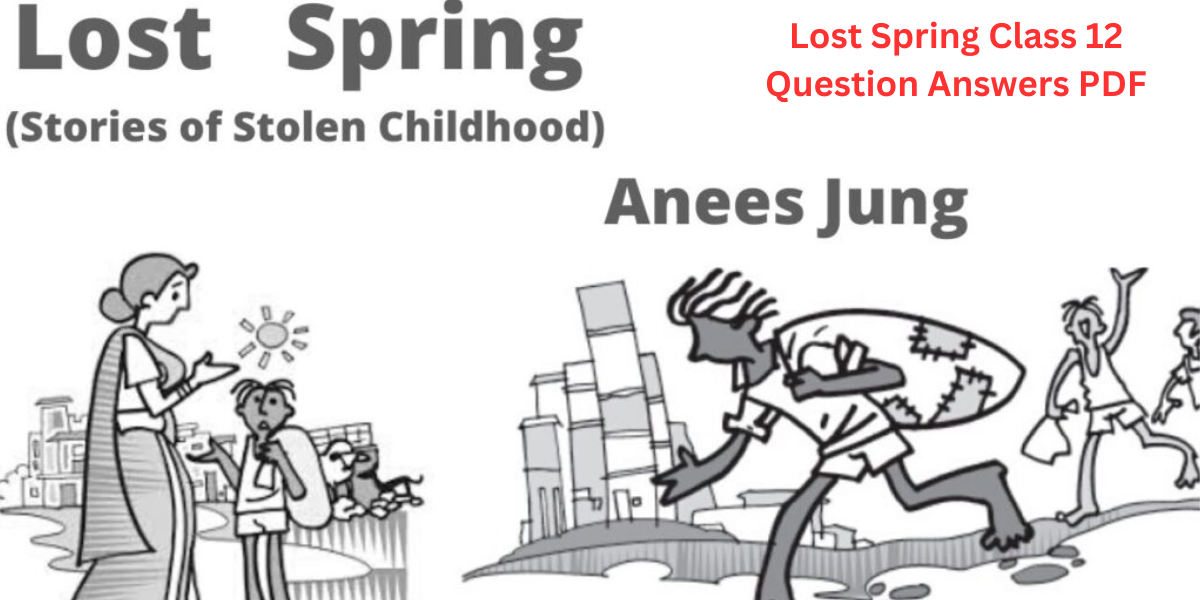Lost Spring Class 12 Question Answers PDF
In the Class 12 English Flamingo textbook, Anees Jung’s chapter “Lost Spring: Stories of Stolen Childhood” offers a powerful and thought-provoking glimpse into the harsh realities faced by impoverished children in India. Through real-life narratives, the author explores the lost childhoods of children who are forced into labor due to poverty, social inequality, and lack of access to education. The chapter is divided into two poignant parts—one focusing on Saheb, a ragpicker from Seemapuri near Delhi, and the other on Mukesh, a child laborer from Firozabad, a town known for its glass bangle industry.

Lost Spring Class 12 Question Answers PDF
Anees Jung uses a journalistic yet sensitive tone to expose how children are denied the basic joys of childhood—play, education, and freedom. Instead of going to school or enjoying their early years, these children are burdened with responsibilities and pushed into hazardous jobs just to survive. The title “Lost Spring” is symbolic of the lost innocence and broken dreams of these young souls whose lives should have been filled with hope and growth, much like the season of spring.
Lost Spring Class 12 Question Answers PDF
1 Why does the author say, “Garbage to them is gold”?
Garbage is a means of survival for the ragpickers. It provides them with something to sell, and sometimes even food. For the children, it holds the hope of finding something valuable.
2 What is Saheb looking for in the garbage dumps? What does he find?
Saheb looks for coins, toys, or anything useful in the garbage. He rarely finds anything significant, but the search itself gives him hope and a sense of purpose.
3 Why does the author describe Saheb as “no longer his own master”?
After taking up work at a tea stall, Saheb loses his independence. Though he earns ₹800 and meals, he is now bound by rules and doesn’t enjoy the freedom he had earlier as a ragpicker.
4 Why did the ragpickers settle in Seemapuri?
The ragpickers migrated from Dhaka due to poverty and natural disasters. In Seemapuri, though they lack basic facilities, they get a place to live and can earn a living by ragpicking.
5 What does the title “Lost Spring” signify in the context of the story?
“Lost Spring” refers to the lost childhood of poor children like Saheb and Mukesh. Spring symbolizes youth and growth, but poverty robs them of education, dreams, and carefree childhood.
6 Why has the poet used the image of ‘young trees sprinting’?
The image of ‘young trees sprinting’ contrasts the old, pale mother with youthful life and energy outside the car. It symbolizes the swift passage of time and the poet’s inner tension.
7 What do the poet’s parting words “See you soon, Amma” signify?
These words express the poet’s hope and reassurance, though she fears it might be her last goodbye. It reflects her love, fear of loss, and emotional strength.
8 How does the poet use imagery to portray the mother’s aging?
The poet compares her mother to a late winter’s moon—pale, faded, and weak. This simile highlights her mother’s old age, fragility, and closeness to death.
9 What is the significance of the title “My Mother at Sixty-Six”?
The title focuses on the central theme—aging and the inevitable separation between mother and daughter. It marks a moment of realization for the poet about mortality and emotional attachment.
10 How does the poet’s mood change from the beginning to the end of the poem?
At first, the poet is calm, but seeing her mother’s aging face fills her with fear and sadness. By the end, she hides her emotions behind a smile, showing both her pain and her strength.
class 12 test 1 PDF😁😁😁
Lost Spring Class 12 Question Answers PDF
MCQs from Lost Spring – Anees Jung
-
Who is the author of “Lost Spring”?
a) Arundhati Roy
b) Anees Jung
c) Jhumpa Lahiri
d) Kamala Das
→ b) Anees Jung -
What is the full title of the chapter?
a) Lost Spring: The Joy of Childhood
b) Lost Spring: Childhood in Mussoorie
c) Lost Spring: Stories of Stolen Childhood
d) Lost Spring: Hope in Despair
→ c) Lost Spring: Stories of Stolen Childhood -
What does ‘lost spring’ symbolize in the lesson?
a) Spring season
b) Lost opportunity to travel
c) Lost childhood and innocence
d) Lost happiness due to migration
→ c) Lost childhood and innocence -
Where is Seemapuri located?
a) Kolkata
b) Mumbai
c) Delhi
d) Chennai
→ c) Delhi -
Why did Saheb’s family come to Seemapuri?
a) To visit relatives
b) To find better education
c) To escape poverty and natural calamities in Dhaka
d) For tourism
→ c) To escape poverty and natural calamities in Dhaka -
What does Saheb do for a living?
a) Beggar
b) Ragpicker
c) Shopkeeper
d) Rickshaw puller
→ b) Ragpicker -
What does Saheb’s name mean?
a) Master
b) Slave
c) Noble
d) Rich
→ a) Master -
What was Saheb’s job after he left ragpicking?
a) Shop assistant in a tea stall
b) Mechanic
c) Cobbler
d) Street vendor
→ a) Shop assistant in a tea stall -
How does Saheb feel after getting a job at the tea stall?
a) Proud and confident
b) Happy and excited
c) Burdened and no longer free
d) Angry and upset
→ c) Burdened and no longer free -
What is the primary occupation of people in Firozabad?
a) Farming
b) Pottery
c) Bangle making
d) Fishing
→ c) Bangle making -
Who is Mukesh?
a) A ragpicker
b) A bangle maker’s son
c) A tea seller
d) A school boy
→ b) A bangle maker’s son -
What is Mukesh’s dream?
a) To become a bangle maker
b) To be a doctor
c) To be a teacher
d) To be a motor mechanic
→ d) To be a motor mechanic -
Where does Mukesh want to go to learn his desired profession?
a) Delhi
b) A garage in his neighborhood
c) Agra
d) A nearby town
→ b) A garage in his neighborhood -
What is the hazard faced by the bangle makers?
a) Physical exhaustion
b) Eye problems and blindness
c) Poor housing
d) Malnutrition
→ b) Eye problems and blindness -
What prevents the bangle makers from organizing themselves into cooperatives?
a) Ignorance
b) Caste and family traditions
c) Fear of police and sahukars
d) Lack of skills
→ c) Fear of police and sahukars -
What is the irony in Saheb’s life?
a) His name means ‘master’, but he is a servant
b) He likes ragpicking
c) He is a millionaire’s son
d) He goes to school
→ a) His name means ‘master’, but he is a servant -
What does the author question about ragpickers?
a) Why they live in Seemapuri
b) Why they wear torn clothes
c) Why children are forced into ragpicking
d) Why they don’t go back to Dhaka
→ c) Why children are forced into ragpicking -
What is the author’s tone in the story?
a) Comic and light
b) Ironic and critical
c) Indifferent
d) Angry and rude
→ b) Ironic and critical -
Why don’t the elders in Firozabad organize themselves?
a) They are too old
b) They think it’s useless
c) They are trapped in a web of poverty and tradition
d) They are rich
→ c) They are trapped in a web of poverty and tradition -
What does the story “Lost Spring” mainly highlight?
a) Fun in the spring season
b) Children’s rights and education
c) Dreams and ambitions of children in poverty
d) Corruption in politics
→ c) Dreams and ambitions of children in poverty






Leave a Reply